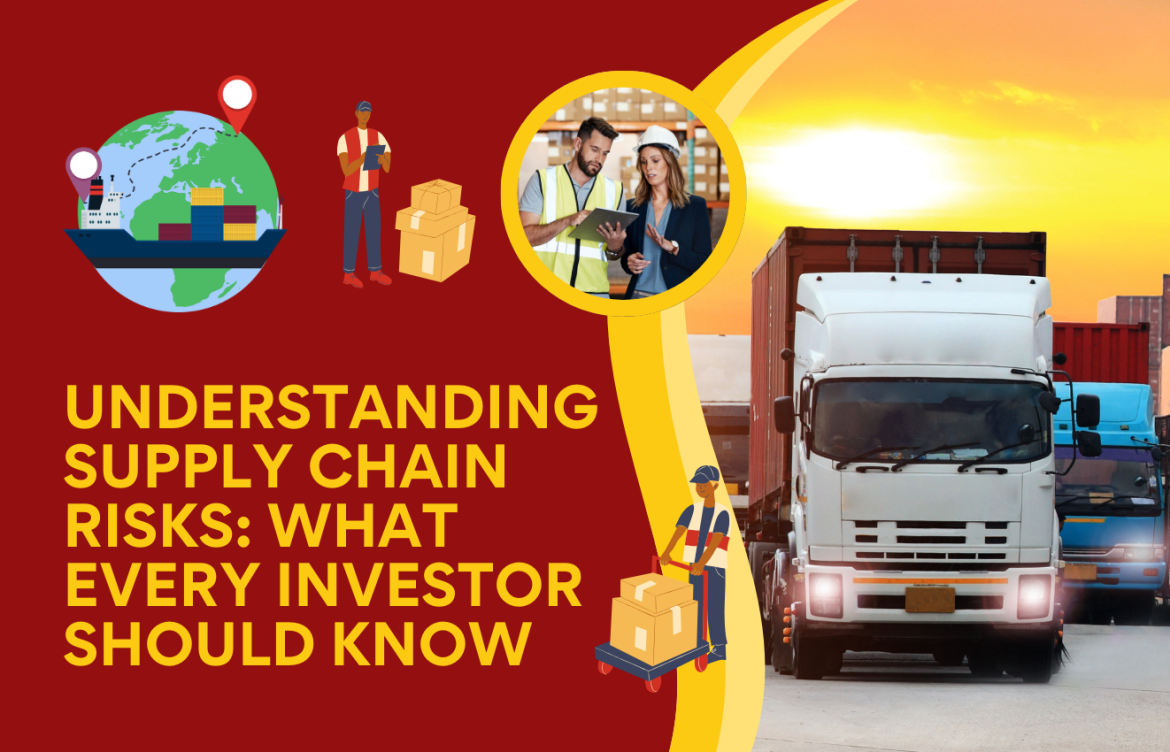
Understanding Supply Chain Risks: What Every Investor Should Know
Understanding Supply Chain Risks: What Every Investor Should Know
In today’s interconnected world, companies don’t operate in isolation—they rely on complex networks of suppliers, manufacturers, logistics partners, distributors, and retailers. This network, known as the supply chain, plays a crucial role in determining a company’s efficiency, profitability, and long-term sustainability.
Thank you for reading this post, don't forget to subscribe!For investors, understanding supply chain risks has become just as important as studying revenue growth or profit margins. Disruptions in supply chains can impact production, inflate costs, delay deliveries, and ultimately affect stock prices.
This blog breaks down what supply chain risks are, why they matter, and how investors can evaluate them before making investment decisions.
What Are Supply Chain Risks?
Supply chain risks are uncertainties or disruptions that affect the flow of goods, services, or information within a company’s supply ecosystem. These risks can arise at any stage—from raw material sourcing to final product delivery.
They include:
-
Operational risks
-
Geopolitical risks
-
Transportation/logistics risks
-
Supplier risks
-
Environmental and climate-related risks
-
Financial risks
-
Technology and cybersecurity risks
When any link in the chain breaks, the entire system can weaken.
Why Supply Chain Risks Matter for Investors
A company with a strong supply chain can better withstand shocks, maintain margins, and deliver consistent performance. But a vulnerable supply chain may lead to:
-
Rising input costs due to scarcity or disruption
-
Lower production output
-
Missed revenue targets due to stock-outs
-
Margin pressure because of expensive alternatives
-
Loss of competitive edge
These risks directly affect financial performance and, therefore, stock valuations.
Example:
During the semiconductor shortage in 2021–22, automobile and electronics companies worldwide faced production cuts. Investors who monitored supply chain risks early were able to anticipate earnings revisions and market reactions.
Types of Supply Chain Risks Investors Should Track
1. Supplier Concentration Risk
Companies heavily dependent on one or two suppliers face major vulnerability.
Red flags:
-
50% of materials from a single supplier
-
Supplier located in politically sensitive or disaster-prone regions
-
Lack of alternative vendor arrangements
Investor Tip: Check the “Risk Factors” and “Management Discussion & Analysis (MD&A)” sections in annual reports.
2. Geopolitical & Regulatory Risks
Trade wars, sanctions, import restrictions, tariffs, and regulatory changes can disrupt global supply chains.
Examples:
-
India’s restrictions on certain imports can affect pharma or electronics players.
-
Global conflicts (e.g., Russia–Ukraine) impact energy and commodity supply.
Investor Tip: Favor companies with diversified sourcing across countries.
3. Logistics & Transportation Risks
Delays in shipping, port congestion, fuel price spikes, and dependency on specific trade routes can disrupt timelines.
Example:
-
The Suez Canal blockage led to billions in delays and higher freight rates.
Investor Tip: Companies with strong warehousing, inventory planning, and multi-route logistics are more resilient.
4. Commodity & Raw Material Price Volatility
Industries like steel, cement, chemicals, FMCG, and textiles depend heavily on raw materials.
Risks include:
-
Sudden spikes in commodity prices
-
Shortages of key inputs
-
Currency fluctuations
Investor Tip: Look for companies with hedging policies or long-term supply contracts.
5. Technological & Cybersecurity Risks
Supply chain systems rely heavily on digital platforms for tracking, planning, and communication.
Risks:
-
Cyberattacks on logistics platforms
-
Software outages
-
Data breaches affecting operations
Investor Tip: Companies investing in digital supply chain management tools tend to be more resilient.
6. Environmental & Climate Risks
Natural disasters, floods, droughts, and extreme weather events can halt production or transport.
Example:
-
Floods affecting industrial clusters in Chennai or Mumbai impact auto and IT manufacturing.
Investor Tip: Environmental risk disclosures in sustainability reports indicate preparedness.
How Investors Can Assess Supply Chain Strength
1. Check the Company’s Supplier Base
-
How many suppliers do they rely on?
-
Are they geographically diversified?
-
Do they disclose contingency plans?
2. Analyze Inventory Management
-
Does the company maintain optimal inventory levels?
-
Are they dependent on “Just-in-Time” setups, which can worsen disruptions?
3. Review Past Disruptions
Historical resilience indicates future strength.
4. Study Working Capital Trends
A stressed supply chain often shows up as:
-
Rising inventory days
-
Higher payables
-
Increasing receivable cycles
5. Look for Technology Adoption
Modern supply chains depend on automation, IoT tracking, data analytics, and ERP systems.
6. Evaluate ESG & Sustainability Practices
Strong ESG frameworks are associated with better supply chain monitoring and risk management.
Sectors Where Supply Chain Risks Matter Most
High-risk industries:
-
Automobiles
-
Electronics & semiconductors
-
Pharmaceuticals
-
Textiles
-
Metals & mining
-
FMCG
Moderate-risk industries:
-
IT services
-
Banking & financials
-
Telecom
Each sector has unique vulnerabilities that investors must understand.
What Strong Supply Chain Management Looks Like
Companies with robust supply chains typically:
-
Have multiple vendors for critical inputs
-
Diversify sourcing geographically
-
Maintain healthy inventory buffers
-
Use supply chain analytics for forecasting
-
Invest in automation and technology
-
Disclose risks transparently
Examples of strong SCM practices:
-
Diversification of component sourcing
-
Long-term contracts with local suppliers
-
Digitized logistics tracking systems
Final Thoughts
Supply chain risks are no longer just an operational concern—they are a major investment consideration. Retail and emerging investors who learn to evaluate these risks gain a major advantage in spotting resilient companies and avoiding vulnerable ones.
A company with a strong supply chain can withstand global shocks, maintain profitability, and deliver long-term value to shareholders.
In short: Supply chain strength is a hidden but powerful indicator of a company’s durability.
Related Blogs:
What Makes a Business Moat? Understanding Competitive Advantage
Risk Management Strategies for Retail Investors
How to Measure Your Risk Appetite Before You Invest
Diversification: Your Portfolio’s Best Friend Against Risk
Risk Management in Equity Investing: Protecting Your Portfolio
How Risk Management Can Save your Trading Account
Disclaimer: This blog post is intended for informational purposes only and should not be considered financial advice. The financial data presented is subject to change over time, and the securities mentioned are examples only and do not constitute investment recommendations. Always conduct thorough research and consult with a qualified financial advisor before making any investment decisions.

